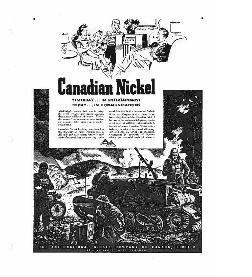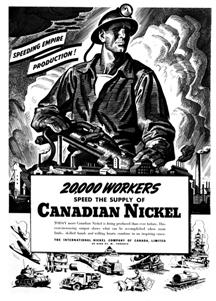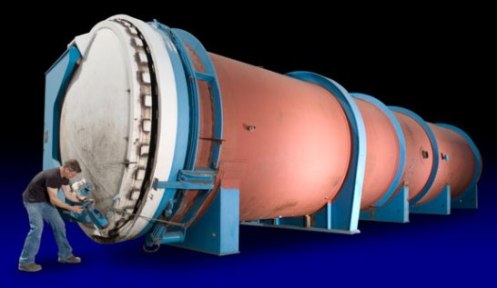Roger Whittle’s Amazing Invention – the Jet Engine
The successful development of British-born Roger Whittle’s amazing invention, the jet turbine engine was integrally linked to Inco’s metallurgical expertise with high temperature nickel alloys.
In the early 1940s, at the request of Britain’s Air Ministry, company scientists worked furiously to solve the problem of appropriate materials for emerging designs in jet and gas turbine engines. The Germans were also working on their own version of a jet engine the Messerschmitt Me 262.
One of the most noted contributions during the war was the invention of a new alloy for jet-propelled aircraft engines by International Nickel metallurgists from the Henry Wiggin & Company Ltd. facilities in Birmingham.
This new alloy called “Nimonic 80” allowed the jet engine’s turbine parts, particularly the blades, to operate for long periods under tremendous stress, high heat and corrosive exhaust without deforming or melting. This new alloy was superior to German aircraft technology. The first British airplane outfitted with the new engine was the Meteor which first flew in 1943 and was finally approved for the air force in July, 1944.





























 In 2008, for the first time in human history, more than half of the global population will be living in cities. The planet is undergoing the largest wave of urban growth ever, spearheaded by the massive migration of Chinese farmers to their cities.
In 2008, for the first time in human history, more than half of the global population will be living in cities. The planet is undergoing the largest wave of urban growth ever, spearheaded by the massive migration of Chinese farmers to their cities. Two weeks ago during Toronto’s annual mining convention, a Memorandum of Understanding (MOU) between the Assembly of First Nations (AFN) – Canada’s national organization for Aboriginal people – and the Prospectors and Developers Association of Canada (PDAC) – an industry lobby group – was signed.
Two weeks ago during Toronto’s annual mining convention, a Memorandum of Understanding (MOU) between the Assembly of First Nations (AFN) – Canada’s national organization for Aboriginal people – and the Prospectors and Developers Association of Canada (PDAC) – an industry lobby group – was signed. The annual Prospectors and Developers Association of Canada (PDAC) convention is the premier event in the global exploration and mining sector. The Toronto convention, which is always held in the first week of March, is expected to set another attendance record this year with about 20,000 visitors.
The annual Prospectors and Developers Association of Canada (PDAC) convention is the premier event in the global exploration and mining sector. The Toronto convention, which is always held in the first week of March, is expected to set another attendance record this year with about 20,000 visitors. The Prospectors and Developers Association of Canada (PDAC) promotes the interests of the Canadian mineral exploration sector to ensure that there is an economically prosperous and competitive mining industry in Canada. A critical part of PDAC’s mandate is to encourage the highest standards of technical, environmental, safety and social practices of the industry both in Canada and internationally.
The Prospectors and Developers Association of Canada (PDAC) promotes the interests of the Canadian mineral exploration sector to ensure that there is an economically prosperous and competitive mining industry in Canada. A critical part of PDAC’s mandate is to encourage the highest standards of technical, environmental, safety and social practices of the industry both in Canada and internationally. Sudbury Mining Supply and Service Industry is Enormous
Sudbury Mining Supply and Service Industry is Enormous While southern Ontario manufacturing and auto industries are under severe economic stress due to the high dollar, competition from China and a U.S. recession, Sudbury’s cluster of mining supply and service (MS&S) companies are growing, exporting their products and technical expertise around the world.
While southern Ontario manufacturing and auto industries are under severe economic stress due to the high dollar, competition from China and a U.S. recession, Sudbury’s cluster of mining supply and service (MS&S) companies are growing, exporting their products and technical expertise around the world. There is no doubt that the impending recession in the U.S. is causing economic upheaval across Ontario which exports about 86% of its manufactured goods to our southern neighbour.
There is no doubt that the impending recession in the U.S. is causing economic upheaval across Ontario which exports about 86% of its manufactured goods to our southern neighbour. According to a comprehensive study by the Mining Industry Training and Adjustment Council (MITAC), the Canadian mining industry needs to fill 81,000 high-paying, highly skilled new positions in the next 10 years.
According to a comprehensive study by the Mining Industry Training and Adjustment Council (MITAC), the Canadian mining industry needs to fill 81,000 high-paying, highly skilled new positions in the next 10 years.